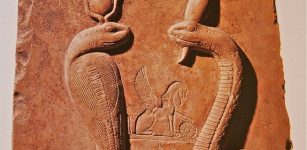Millennia Old Extremely Complex Object Of Unknown Origin
A. Sutherland - AncientPages.com - Aluminum (also aluminium) was used at least 7,000 years ago and our modern discovery of this valuable metal is nothing but a re-invention based on the knowledge our ancestors already possessed.
Danish physicist Hans Christian Oersted - credited for the invention of aluminum - was not the first person who invented aluminum. This metal was used at least 7,000 years ago and our modern discovery of this valuable metal is nothing but a re-invention based on the knowledge our ancestors already possessed.
The mysterious object, approximately 1mm thick and covered with a layer of aluminum oxide was discovered in Aiud, Romania. It's considered to be millennia old.
While excavating in Iraq, archaeologists discovered pottery produced around 5,300 B.C. These artifacts were made of clay that contained aluminum. There is also archaeological evidence Egyptians and Babylonians used aluminum compounds in various medicines and chemicals almost 4,000 years ago.
In his writings, Pliny the Elder (AD 23 – 79.), a Roman scholar described an element he called alumen.
At the beginning of 1974, a strange object was brought to light by a group of construction workers digging in the area of central Romania.
The discovery was made at the depth of approximately ten meters, in the sediments of the river Mures, 2 km east of Aiud, and about 50 km south of Cluj-Napoca, the former capital of Transylvania. This artifact was discovered together with very ancient bones, (including the jaw) of a mastodon, in a sandpit under a 35-foot-thick layer of sand.
Such an extraordinary finding raises interesting questions that cannot be answered easily.
At first, the finding appeared to be a dark stone, but after removing the thick crust of sand from its surface, it was revealed a metal object of unknown origin.
The specimen is 20.2 cm long, 12.7 cm wide, 7 cm high, and has a circular depression (4 cm in diameter) in the center.
Another smaller hole with a diameter of 1.7 cm and perpendicular to the first exit is on the other side of the mysterious object. This and the two side panels show evidence suggesting that they may have been obtained as a result of very strong shocks. Was it once a part of a larger tool? Still, the purpose of this tool remains unknown.
Two fin-shaped protrusions at the end of the artifact are clearly visible, but their purpose is unknown.
In the beginning, no one was particularly interested in the artifact, so it landed in a storage room at the Historical Museum of Transylvania and remained there unnoticed for 21 years.
It was not until 1995, the piece of metal, weighing 2.3 kilograms was "rediscovered" and analyzed.
A detailed metallurgical analysis conducted at the Institute for Research of Minerals and Metals in Turnu Magurele, a city located south-west of Bucharest, has revealed that the object in question was extremely complex and consisted of an alloy of several elements, such like:
89% aluminum,
6.2% Cu copper,
2.8% Si silicon,
1.8% Zn Zinc,
0.4% Pb Lead,
0.3% Sn tin,
0.2% Zr zirconium,
0.1% Cd cadmium.
Additionally, small parts of nickel (Ni), cobalt (Co), bismuth (Bi), silver (Ag), and trace amounts of gallium (Ga) were also found.
The object was composed largely of aluminum (89%), a metal often found in nature, however, not only in pure form but the state of bauxite, from which most aluminum is extracted.
As we know, the aluminum was discovered in 1825 by H. C. Oersted and produced for the first time on an industrial scale in France in 1854.
However, it would take years upon years of deliberate research to find an efficient method to unlock the metal from its ore and even more years to create a production process that would allow the metal to be commercially practical.
For the production of aluminum, you need a complicated industrial process, electrolysis, and temperatures above 900 ° C.
This mysterious object found in Aiud, which is considered at least tens of thousands of years old, was covered with a layer of aluminum oxide about 1 mm thick.
"Aluminium" knowledge was apparently rediscovered by us quite so recently.
So, what is this old artifact?
Written by – A. Sutherland - AncientPages.com Senior Staff Writer
Copyright © AncientPages.com All rights reserved. This material may not be published, broadcast, rewritten or redistributed in whole or part without the express written permission of AncientPages.com
More From Ancient Pages
-
 The Mystery Of Serpent Worship
Featured Stories | Jun 25, 2019
The Mystery Of Serpent Worship
Featured Stories | Jun 25, 2019 -
 Mysterious Gosford Glyphs: Remarkable Ancient Egyptian Hieroglyphs Discovered In Australia Could Re-Write History
Featured Stories | Feb 20, 2020
Mysterious Gosford Glyphs: Remarkable Ancient Egyptian Hieroglyphs Discovered In Australia Could Re-Write History
Featured Stories | Feb 20, 2020 -
 Hidden Byzantine Hoard Offers Evidence Of A Dramatic Historial Event In The Levant
Artifacts | Oct 13, 2022
Hidden Byzantine Hoard Offers Evidence Of A Dramatic Historial Event In The Levant
Artifacts | Oct 13, 2022 -
 Garamantes: 3,000-Year-Old Sophisticated North African Society Built 3,000-Mile Network Of Underground Irrigation Canals
Featured Stories | Jan 29, 2022
Garamantes: 3,000-Year-Old Sophisticated North African Society Built 3,000-Mile Network Of Underground Irrigation Canals
Featured Stories | Jan 29, 2022 -
 Legend Of The Blue Men Of Minch: Were They Mythological Creatures Or Real Men?
Featured Stories | May 13, 2016
Legend Of The Blue Men Of Minch: Were They Mythological Creatures Or Real Men?
Featured Stories | May 13, 2016 -
 Secret High-Tech Knowledge Hidden In Ancient Manuscripts And The Mysterious Seven Sky Kings
Ancient Mysteries | Aug 24, 2021
Secret High-Tech Knowledge Hidden In Ancient Manuscripts And The Mysterious Seven Sky Kings
Ancient Mysteries | Aug 24, 2021 -
 The Olympics In Ancient And Modern Times – What Has Changed?
Featured Stories | Jun 20, 2019
The Olympics In Ancient And Modern Times – What Has Changed?
Featured Stories | Jun 20, 2019 -
 Unique Virtual Look At Gamla Uppsala: Sacred Ancient Viking And Pagan Site In Sweden
Civilizations | Sep 19, 2016
Unique Virtual Look At Gamla Uppsala: Sacred Ancient Viking And Pagan Site In Sweden
Civilizations | Sep 19, 2016 -
 Ancient Secrets Of The Masters Of Mu – Myths And Legends Examined – Part 1
Ancient Mysteries | Aug 24, 2018
Ancient Secrets Of The Masters Of Mu – Myths And Legends Examined – Part 1
Ancient Mysteries | Aug 24, 2018 -
 Kukulkan (Quetzalcoatl): Feathered Serpent And Mighty Snake God
Featured Stories | Feb 7, 2017
Kukulkan (Quetzalcoatl): Feathered Serpent And Mighty Snake God
Featured Stories | Feb 7, 2017 -
 Mystery Of The Wizard Clip – Unexplained Half-Moon Clippings And Supernatural Phenomena West Virginia
Featured Stories | Jul 15, 2024
Mystery Of The Wizard Clip – Unexplained Half-Moon Clippings And Supernatural Phenomena West Virginia
Featured Stories | Jul 15, 2024 -
 Hayk – Legendary Patriarch And Founder Of Armenia Who Defeated King Bel Of Babylon
Featured Stories | Feb 10, 2022
Hayk – Legendary Patriarch And Founder Of Armenia Who Defeated King Bel Of Babylon
Featured Stories | Feb 10, 2022 -
 Ancient ‘Cosmic’ Artifacts – Ancient Civilizations Used Meteoric Iron Much Earlier Than Previously Thought
Archaeology | Dec 6, 2017
Ancient ‘Cosmic’ Artifacts – Ancient Civilizations Used Meteoric Iron Much Earlier Than Previously Thought
Archaeology | Dec 6, 2017 -
 Ancient Mysteries Of The Amazon Jungle – Survivors Of The Great Flood Or An Atlantean Race Hidden In The Forest? – Part 2
Ancient Mysteries | May 29, 2018
Ancient Mysteries Of The Amazon Jungle – Survivors Of The Great Flood Or An Atlantean Race Hidden In The Forest? – Part 2
Ancient Mysteries | May 29, 2018 -
 Legend Of Kitezh – Ancient Underwater City And Its Doomsday Prophecy
Featured Stories | Mar 14, 2017
Legend Of Kitezh – Ancient Underwater City And Its Doomsday Prophecy
Featured Stories | Mar 14, 2017 -
 Scylla And Charybdis – Legendary Greek Sea Monsters – Choosing The Lesser Of Two Evils
Featured Stories | Jan 15, 2021
Scylla And Charybdis – Legendary Greek Sea Monsters – Choosing The Lesser Of Two Evils
Featured Stories | Jan 15, 2021 -
 Mighty Enlil Of The Sumerian Pantheon Of Gods
Featured Stories | Feb 22, 2017
Mighty Enlil Of The Sumerian Pantheon Of Gods
Featured Stories | Feb 22, 2017 -
 Tomb Of Nicolaus Copernicus: Is The Mystery Surrounding Astronomer’s Burial Place Really Solved?
Featured Stories | Apr 13, 2018
Tomb Of Nicolaus Copernicus: Is The Mystery Surrounding Astronomer’s Burial Place Really Solved?
Featured Stories | Apr 13, 2018 -
 Medieval Manuscript Reveals Surprising Discovery Of Star Wars Master Yoda & Shocking Monsters
Artifacts | Apr 27, 2015
Medieval Manuscript Reveals Surprising Discovery Of Star Wars Master Yoda & Shocking Monsters
Artifacts | Apr 27, 2015 -
 Aoife: Beautiful Female Warrior, Lover Of Cuchulainn And Mother Of His Only Son In Irish Beliefs
Celtic Mythology | Mar 18, 2019
Aoife: Beautiful Female Warrior, Lover Of Cuchulainn And Mother Of His Only Son In Irish Beliefs
Celtic Mythology | Mar 18, 2019





